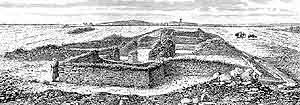- Home
- Megalithism in Morbihan
- Carnac
- Before and after the Megaliths
Many remains dating from periods earlier and later than the Neolithic Age have been found all over the Carnac area. The fame of the megaliths should not be allowed to overshadow the importance of these other finds.
- The Lower Palaeolithic Age: traces of human presence were found near the village of Saint-Colomban. They are several hundred thousand years old and are listed amongst the oldest deposits in western France.
- The Bronze Age: Bronze Age artefacts found in megalithic monuments indicate that the latter were still in use at the time.Two gold leaf necklaces ("gargantillas") were discovered in the 19th century, during the first excavations of the Rondossec dolmens at Plouharnel and late artefacts were found in small mounds.
- The Iron Age: a few tombs were still in use -especially around Le Bono- together with early salinas (ovens used to extract salt before the development of salt-marshes). Several characteristic "steles", such as the one now used as a base for the orientation table on top of the Saint-Michel tumulus, also date from that period. These monoliths are the "menhirs" Obelix is supposed to have carried around and should not be confused with the real neolithic megaliths…
- The Roman Period: human settlements developed all along the Morbihan coastline. Amongst the most famous sites are those located at the head of the Kermario alignments and the large Bosseno villa. These sites were studied by J. Miln at the end of the 19th century.
Next slide
Previous slide
A view of the Bosseno villa during the excavations led by James Miln.
The Christianised fountain below the Saint-Michel tumulus, itself topped with a chapel.
Roman ceramic sherds found in many megaliths of the Carnac area prove the monuments were also occupied by the Romans. They actually used some of the megaliths as small places of worship, like Le Petit-Mont in Arzon.
- The Middle Ages: the landscape became dotted with Christian signs (crosses along the roads, fountains, chapels, etc.). A number of megalithic monuments were christianised, like the Saint-Michel tumulus and the Cruz-Moquen dolmen. Other megaliths were probably destroyed or dramatically altered. It is said that several of Carnac's ancient roadside crosses, such as the Kerluir and Coet-a-Tous crosses, were carved out of menhirs.
- Recent periods: the salinas brought prosperity. Hence the magnificent parish church, built during the 17th and 18th centuries, which replaced an older Romanesque church. The sea also brought another kind of prosperity to Carnac and altered the landscape at the end of the 19th century through the development of the "seaside resort" the architecture at Carnac-plage bears witness to the opening up of the area when the railway was built.

